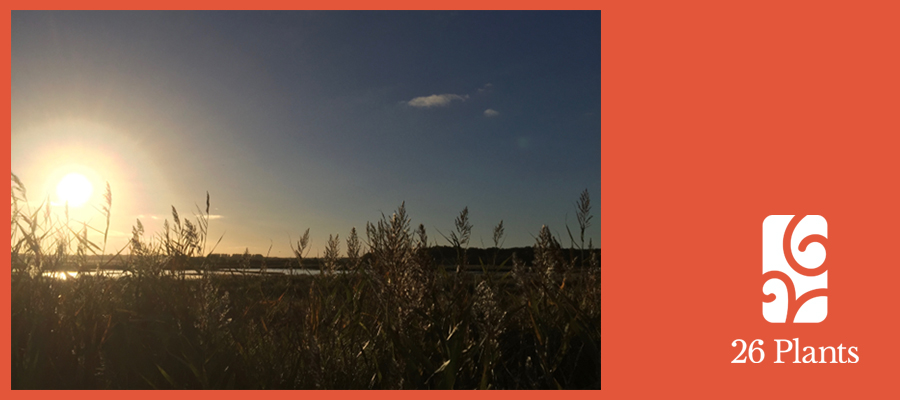Common Reed
Phragmites australis
Sue Young

Sanctuary
A feather sea shivers at the wind’s gentle touch. Silver shimmer, like captured moonlight, ripples across the marsh. Tall amethyst plumes sway to brush the skyline as the sun sinks.
Starlings murmur. Hush, the reeds share whispered secrets. Hide.
Drop down, into a dim geometry of tall stems. Criss-cross leaves. Hollow canes sheathed in shadow. Through rustling reed where bunting and warblers shelter and the bittern booms in chiaroscuro safety.
Roots hold fast, pushing rhizomes through mud and shallow water, knotted in dense mats to fringe rivers and cloak marsh and house a thousand creatures beneath a feather sea.
I once did a night-time wildlife survey in a reedbed. It was early spring, dark and cold. Water lapped the toes of my boots. I tested each step lest I reach an edge and plunge into unexpected depths. Reeds swayed and rustled above my head, last year’s bleached growth brittle and harsh while this year’s shoots were yet to push up through the mud. I was looking for newts, shining a bright light into the water, sending beetles and other small beasts scurrying under leaf debris to burrow beneath knotted roots. The night was silent except for the susurration of the reeds, small flurries and settlings in the shadows and the squelch and suck of my boot-steps.
The land was soon to be drained, then buried under tarmac and luxury homes. It’s a shrinking habitat, reedbed. Over a third has disappeared within living memory, drained for farming or to be built upon. Most of the rest is fragmented, isolated and small. Which is why, despite the fact that this common and cosmopolitan plant is found across the globe, the reed Phragmites australis is the centrepiece of many wetland conservation projects.
“We’re planting 20,000 reed plugs this summer” the reserve manager explained when I visited Brandon Marsh a few years ago. The Wildlife Trust planned to create new breeding habitat for bittern and marsh harriers. The reeds would be planted in submerged shelves along specially dug ditches, each plug spidering out horizontal shoots and new stems, six foot high, slender leaved and densely packed. Before long, these reedy fringes would provide homes for nature. Raptors and warblers, water voles and otters, frogs, fish, beetles, moths and a host of other invertebrates all find a refuge in the stands of common reed.
Weeks later I was at another reserve, in Yorkshire, watching a sea of feathery reed-heads ripple in the wind. This huge reedbed had been completed just two years before, after five years of hard work. “The bitterns moved in as soon as it was finished. Marsh harriers too, the first time they’ve bred in Yorkshire for 350 years.”
That’s why this plant is so special. It’s a world-builder, it can form a vast habitat that provides shelter and safety for many animals. Sanctuary for wildlife which is declining rapidly, wildlife which is at risk of extinction, and wildlife pulling back from the brink.
Image: Photo by Sue Young
